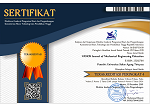THE INDEPENDENCE AND ACTIVENESS (KEMANTI) – BASED ACTIVE LEARNING STRATEGY TO IMPROVE COOPERATION AND LEARNING OUTCOMES
Abstract
This research was aimed to find out the improvement of cooperation and student learning outcomes by implementing active learning strategies based on the independence and activeness (KEMANTI). The design of this research adopted Classroom Action Research. The learning strategy of KEMANTI was applied in SMK Muhammadiyah 1 Salam Magelang. The stages of research resulted in the improvement of student cooperation can be seen from each aspect of cooperation which includes aspect of giving idea or opinion up 30%; accepting the opinion of others up 50%, carrying out the tasks given by the group up 30%, the nature of helping others up 40%, and the last aspect is concern for the difficulties of fellow group members up 50%. Improvement of student learning outcomes is shown by the value of effect size 3.2. The difference in learning outcomes uses t Test which shows that t tab is 4.9 in cycle I and t tab is 16,9 in cycle II. Test Results t post-test cycles I and II t hit> t tab is 15.00> 2.0. The conclusion of the t test results is that there is a difference from pre-test and post-test in cycle I and cycle II after being given an active learning strategy of KEMANTI.
Keywords
Full Text:
PDFReferences
Abizar, H. (2016). Pengembangan Perangkat Pembelajaran Lesson Study Pada Paket Keahlian Teknik Pemesinan Di SMK. VANOS Journal of Mechanical Engineering Education, 1 (2), Tahun 2016, pp. 103-124.
Anas Sudijono. 2003. Pengantar Statistik Pendidikan. Jakarta: Raja Grafindo Persada
Dewi Apriyani dan Idris Harta. 2013. Upaya Meningkatkan Kerjasama Siswa dalam Pembelajaran Matematika Melalui Model Pembelajaran Tutor Sebaya (PTK pada Siswa Kelas Viii A Semester Genap Smp Negeri 1 Karangnongko Tahun Ajaran 2012/2013) . Thesis. Muhammadiyah University of Surakarta
Graff D. 2005. Research and Practise of Active Learning in Engeneering Educators. Amsterdam : Amsterdam University Press
Kemmis Stephen & McTaggart Robin. 1990. The Action Research Planner.Victoria :Deakin University
Ken Petress. 2008. What is Mean By “Active Learning?”. Maine : Research Library
Paulson, D.R. dan Jennifer, L. F. 2009. Active Learning For The College Classroom. Los Angeles : California State University
Raharjo, B., 2003. Manajemen Berbasis Sekolah. Jakarta : Direktur Jenderal Pendidikan Dasar dan Menengah
Ratnawati,D. and Setuju. (2016). ‘Profil Soft Skills Pada Mahasiswa Tingkat Akhir Pendidikan Teknik Mesin di Universitas Sarjanawiyata Tamansiswa’, Journal of Mechanical Engineering Education 1(2), pp 125-134.
Samadhi, A. 2009. Pembelajaran Aktif (Active Learning). Jakarta: TIW (Teaching Improvement Workshop)
Setuju, S. (2017). Implementation Of Project Based Learning Model For Improving Students Learning Outcomes Of Advanced Machining Engineering In Universitas Sarjanawiyata Tamansiswa. VANOS Journal of Mechanical Engineering Education, 2(1).
Wiriaatmadja R., 2005. Metode Penelitian Tindakan Kelas. Bandung : Rosda Karya
Winarno. 2003. Perencanaan Pembelajaran. Jakarta : Direktur Jenderal Pendidikan Dasar dan Menengah
DOI: http://dx.doi.org/10.30870/vanos.v3i1.3473
Refbacks
- There are currently no refbacks.

This work is licensed under a Creative Commons Attribution 4.0 International License.


.png)
.png)
